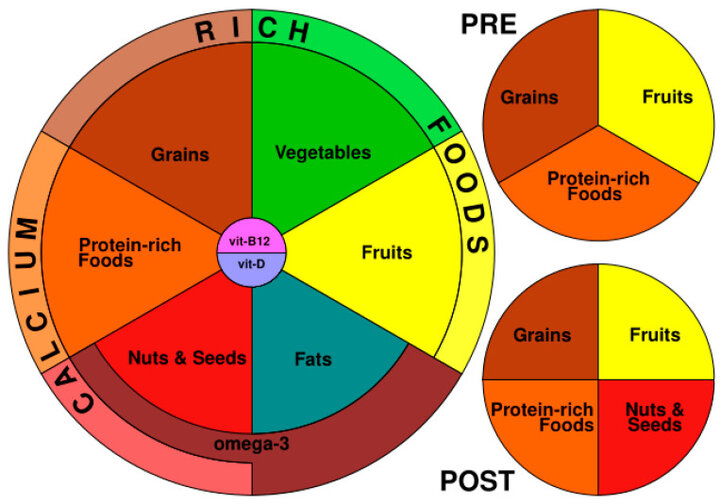KEYWORDS
Sports nutrition
Vegetarian
Vegan
Vegetarian Food Guide
Front-of-pack nutrition labelling
Excercise
Diet
Proper sports nutrition can make the difference between peak athletic performance and hitting the wall early in competition. While many dietary paradigms exist for athletes, there has been increased interest in vegetarian-based diets in recent years. This dietary pursuit provides new challenges to athletes and nutrition programmers to meet the necessary nutritional requirements without meat and fish-based sources. VegPlate, a Mediterranean-Based, Vegetarian Food Guide (VFG) was developed because the Italian Department of Health lacked any recommendations for vegetarians. More recently, VegPlate for Sports was introduced by adjusting dietary components of the original VegPlate to meet the needs of an athlete. This modified version of the original VegPlate provides a resource for vegetarian athletes to ensure they meet their dietary needs.
Abstract
Introduction
Throughout history, humans have consumed plant-based diets due to food availability or religious beliefs. Most of the reasons for practicing vegetarian diets have remained unchanged for the last two and half thousand years. The Greek philosopher and mathematician, Pythagoras, is commonly thought of as the father of ethical vegetarianism, and his ideas influenced nutrition in Europe until the early 19th century (1). In more recent times, vegetarian, vegan and gluten-free diets have attracted the most interest worldwide (2). The motivation to shift towards plant-based diets has been linked to several factors, including health benefits and concerns for animal welfare and the environment (3). This has created the need for Vegetarian Food Guides (VFGs) to ensure that vegetarian eaters are consuming a balanced nutritional profile that meets their dietary needs.
With the rise in vegetarian eaters, we have also seen a rise in vegetarian athletes. This increased interest spurred yet another demand for VFGs: to become tailored to athletes and their specific requirements. A survey conducted at the University of Winchester, United Kingdom found that 33% of those who responded were interested in some form of a vegetarian or vegan diet, and another 29% were considering it. Another survey conducted at the University of Oxford found that 33% of more than 200 endurance athletes were vegetarian or vegan (6). Elite athletes such as multiple time Wimbledon champion, Novak Djokovic, and Real Betis defender, Héctor Bellerín, demonstrate that it is possible to compete at a high level on a plant-based diet (7). However, intentional planning must go into addressing the nutritional needs of athletes to maintain their peak sporting performance. Proper nutritional planning is critical because vegetarians are reported to be at a higher risk for deficiencies in B12 and iron, as well as inadequate protein intake (8,9,10). While some Vegetarian Food Guides (VFGs) have been proposed since 1997, no VFG had been proposed specifically to meet the needs of athletes until 2023, when VegPlate for Sport was introduced (6).
VegPlate for Sport provides a practical tool for nutrition professionals to satisfy athletes’ nutritional needs because it outlines nutritional requirements, energy needs and offers modifications based on activity levels. However, to understand how Veg Plate for Sport works, we must first understand its predecessor – VegPlate.

The original VegPlate
Baroni et. al published the original VegPlate in 2017 in the article VegPlate: A Mediterranean-Based Food Guide for Italian Adult, Pregnant, and Lactating Vegetarians. The motivation for creating the original VegPlate came from the recognition that vegetarian diets were gaining popularity, and that the Italian Department of Health had not made any specific nutritional recommendations for vegetarians up to that time (11).
VegPlate is based on the Italian Daily Recommended Intakes (DRIs) for adults planning to consume between 1200-3200kcal with modifications for women who were pregnant and lactating (11). Serving sizes were calculated based on nutritional profiles of selected foods from the European Institute of Oncology and the United States Department of Agriculture food databases. The original VegPlate consists of six main food groups: grains, protein-rich foods, vegetables, fruits, nuts and seeds with recommended foods within each group based on nutritional profiles and Mediterranean dietary traditions. An additional two groups were included: calcium rich and Omega-3 rich foods.
The layout of VegPlate
The ingenuity of VegPlate comes from its easy-to-use layout. The main plate is divided into six areas representing the six food groups with two “cross-sectional” areas and contains nutrients considered essential in all stages of life: calcium, Omega-3 fatty acids, vitamins B-12 and D.
- Calcium rich foods are spread across all food groups, except fats
- Omega-3 rich foods are spread across part of the nuts and seeds food groups, as well as the fats group
- Vitamins B-12 and D are located in the center of the plate to highlight their importance in a plant-based diet
This model also makes use of small side plates which are added to the main plate for pregnancy and lactation to account for the increased caloric needs. We will see these food groups and the use of side plates again to form the backbone of VegPlate for Sport with modifications to tailor this nutrition plan to athletes. VegPlate also allows for the consideration of discretionary, or “empty” calories (11).
VegPlate for sport
VegPlate for Sport was released in 2023 as a VFG specifically designed for athletes wishing to follow a plant-based diet. As stated earlier, there has been an increase in the interest in vegetarian diets among athletes. Some of the reasons for this shift include (6):
- Health Benefits: possible decreased risk of ischemic heart disease of up to 25%
- Environmental Sustainability: concerns regarding impact on the environment
- Ethical Concerns: regarding the treatment of animals
- Improved Athletic Performance: some evidence suggests better recovery and endurance performance on plant-based diets
- Weight Management: Vegan diets specifically tend to be lower in calories and high in fiber, which can help promote satiety and weight loss
VegPlate for Sport follows a similar layout to the original VegPlate in maintaining six major food groups and two cross-sectional food groups (6):
- Plant foods: grains, legumes, vegetables, fruits, and nuts and seeds (dairy products and eggs are considered optional)
- Fats of plant origin, including good sources of Omega-3 fatty acids (flaxseeds, chia seeds, and walnuts)
- Reliable sources of calcium, and regular inclusion of both Vitamin B12 and vitamin D
The adaptation of VegPlate for use by athletes
VegPlate for Sport was created using the framework of VegPlate with modifications for athletes. First, fiber intake was reduced as much as possible, by choosing non-whole grains, and limiting the servings of fruits and vegetables to a maximum of five. This was done to avoid the risk of stomach upset during training and competition (12). Second, they eliminated the minimum number of calcium rich foods required, as needs would be met via the variety of foods consumed. Third, pre- and post-workout plates were included in addition to the main meals to account for increased energy needs around periods of exercise. VegPlate for Sport still recommends consuming at least two servings of Omega-3 rich foods and the Vitamin D and B12 recommendations remain consistent with those of the original VegPlate (6).
The number of servings per day for VegPlate for Sport were calculated based on an 1800-3200kcal diet for athletes of both sexes ranging from 50-90kg. Basal Metabolic Rate (the amount of energy a person needs to keep the body functioning at rest) was increased by 30% from the original VegPlate to provide the required energy and nutrients for the athlete’s main meals of the day. The pre- and post-workout plates are adapted for the body’s needs before and after exercise (6). The VegPlate for sport is shown below (figure 1).
- The preworkout plate, the “pre-VegPlate”, includes 1.5 g/kg of carbohydrate (mostly slow-released), and 0.3 g/kg of protein
- The postworkout plate, the “post-VegPlate”, includes 1.0 g/kg of carbohydrate (mostly simple), and 0.3 g/kg of protein
- ‘g/kg’ is grams of protein or carbohydrate to consume per kilogram of bodyweight. For example, a person weighing 75kg should consume roughly 112.5g of carbohydrate on their preworkout plate
VegPlate for Sport can be scaled up or down depending on factors such as bodyweight, nutritional needs and daily workout intensities. The resources provided in the original VegPlate and Veg Plate for Sport articles (11,6) give ample food recommendations to meet the needs of most any athlete, or conscious vegetarian eater. A combination of the right nutritional strategies and proper workout planning will lead to the best results and athletic performance. Diets should be based on bodyweight and lean mass, but adjusted specifically for each athlete’s needs. One should ensure that the vegetarian eater is consuming the correct amount of macronutrients in the form of carbohydrate (3–12 g/kg/day) and protein (1.2–2 g/kg/day), as well as a balance of fats (including saturated, monounsaturated, and polyunsaturated types) (6). The food choices and serving suggestions provided in the VegPlate for Sport provide the basis for meeting the daily macronutrient needs for athletes.

Figure 1. the VegPlate for Sport, showing the main plate and the pre- and postworkout plates (6). Created by Baroni et al. Licensee MDPI, Basel, Switzerland. This article is an open access article distributed under the terms and conditions of the Creative Commons Attribution (CC BY) license https://creativecommons.org/licenses/by/4.0/
Conclusion
With the recent rise in vegetarian eaters across the globe, new VFGs are required to provide guidance to ensure that daily nutritional needs are met. Using these guidelines, professional and amateur vegetarian athletes have the opportunity to enhance their performance by tailoring their diets based on sport-specific needs. With new food guides such as VegPlate, and now VegPlate for Sport, athletes and sport nutritionists alike will be better equipped to create effective meal programs using evidence-based resources.
References and notes
- Leitzmann C. Vegetarian nutrition: past, present, future. The American journal of clinical nutrition. 2014 Jul;100 Suppl 1:496S-502S. https://pubmed.ncbi.nlm.nih.gov/24898226/
- Kamiński M, Skonieczna-Żydecka K, Nowak JK, Stachowska E. Global and local diet popularity rankings, their secular trends, and seasonal variation in Google Trends data. Nutrition (Burbank, Los Angeles County, Calif). 2020;79–80:110759. https://pubmed.ncbi.nlm.nih.gov/32563767/
- Clem J, Barthel B. A Look at Plant-Based Diets. Missouri medicine. 2021;118(3):233–8. https://www.ncbi.nlm.nih.gov/pmc/articles/PMC8210981/
- Hargreaves SM, Raposo A, Saraiva A, Zandonadi RP. Vegetarian Diet: An Overview through the Perspective of Quality of Life Domains. International journal of environmental research and public health. 2021 Apr 12;18(8). https://www.ncbi.nlm.nih.gov/pmc/articles/PMC8069426/
- Katharina C W. Vegan Diet in Sports and Exercise – Health Benefits and Advantages to Athletes and Physically Active People: A Narrative Review. International Journal of Sports and Exercise Medicine. 2020 May 16;6(3). https://clinmedjournals.org/articles/ijsem/international-journal-of-sports-and-exercise-medicine-ijsem-6-165.php
- Baroni L, Pelosi E, Giampieri F, Battino M. The VegPlate for Sports: A Plant-Based Food Guide for Athletes. Nutrients. 2023 Apr 3;15(7). https://pubmed.ncbi.nlm.nih.gov/37049586/
- https://www.veganfoodandliving.com/features/vegan-athletes-plant-based-diet/ .
- Hernández-Lougedo J, et al. The Relationship between Vegetarian Diet and Sports Performance: A Systematic Review. Nutrients. 2023 Nov 6;15(21). https://www.ncbi.nlm.nih.gov/pmc/articles/PMC10647346/
- Nieman DC. Physical fitness and vegetarian diets: is there a relation? The American journal of clinical nutrition. 1999 Sep;70(3 Suppl):570S-575S. https://pubmed.ncbi.nlm.nih.gov/10479233/
- Mariotti, Gardner. Dietary Protein and Amino Acids in Vegetarian Diets—A Review. Nutrients. 2019 Nov 4;11(11):2661. https://pubmed.ncbi.nlm.nih.gov/31690027/
- Baroni L, Goggi S, Battino M. VegPlate: A Mediterranean-Based Food Guide for Italian Adult, Pregnant, and Lactating Vegetarians. Journal of the Academy of Nutrition and Dietetics. 2018 Dec;118(12):2235–43. https://pubmed.ncbi.nlm.nih.gov/29170002/
- Jang LG, et al. The combination of sport and sport-specific diet is associated with characteristics of gut microbiota: an observational study. Journal of the International Society of Sports Nutrition. 2019 Jan 15;16(1). https://www.ncbi.nlm.nih.gov/pmc/articles/PMC6500072/

